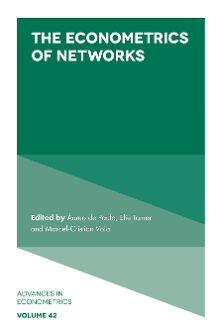
Index
ISBN: 978-1-83867-576-9, eISBN: 978-1-83867-575-2
ISSN: 0731-9053
Publication date: 19 October 2020
Citation
(2020), "Index", de Paula, Á., Tamer, E. and Voia, M.-C. (Ed.) The Econometrics of Networks (Advances in Econometrics, Vol. 42), Emerald Publishing Limited, Leeds, pp. 369-377. https://doi.org/10.1108/S0731-905320200000042019
Publisher
:Emerald Publishing Limited
Copyright © 2020 Emerald Publishing Limited
INDEX
Index
Note: Page numbers followed by “n” indicate notes.
- Prelims
- Section 1 Identification of Network Models
- Chapter 1: Identification and Estimation of Network models with Heterogeneous Interactions
- Chapter 2: Identification Methods for Social Interactions Models with Unknown Networks
- Chapter 3: Snowball Sampling and Sample Selection in a Social Network
- Section 2 Network Formation
- Chapter 4: Trade Networks and the Strength of Strong Ties
- Chapter 5: Application and Computation of a Flexible Class of Network Formation Models
- Section 3 Networks and Spatial Econometrics
- Chapter 6: Implementing Faustmann–Marshall–Pressler at Scale: Stochastic Dynamic Programing in Space
- Chapter 7: A Spatial Panel Model of Bank Branches in Canada
- Chapter 8: Full-information Bayesian Estimation of Cross-sectional Sample Selection Models
- Chapter 9: Survival Analysis of Bank Note Circulation: Fitness, Network Structure, and Machine Learning
- Section 4 Applications of Financial Networks
- Chapter 10: Financial Contagion in Cross-holdings Networks: The Case of Ecuador
- Chapter 11: Estimating Spillover Effects with Bilateral Outcomes
- Chapter 12: Interconnectedness through the Lens of Consumer Credit Markets
- Chapter 13: FRM Financial Risk Meter
- Index